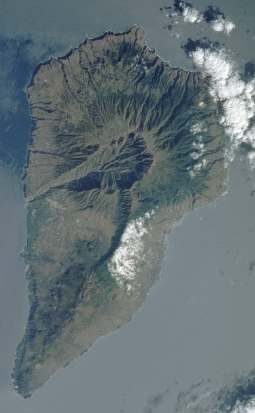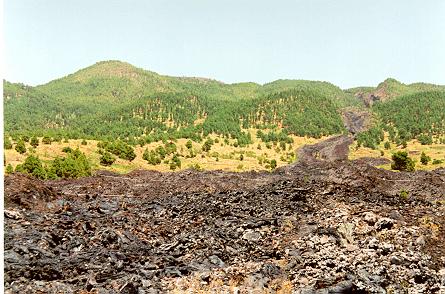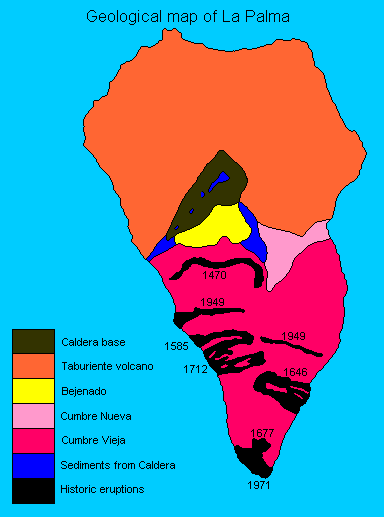September 01, 2004 Mega-tsunami returns
 The Benfield Hazard Research Centre , the British research unit responsible for the 2001 report claiming that a mega-tsunami might be triggered by the eruption of the Cumbre Vieja volcano on La Palma in the Canaries, has teamed up with scientists from the University of California. The Benfield Hazard Research Centre , the British research unit responsible for the 2001 report claiming that a mega-tsunami might be triggered by the eruption of the Cumbre Vieja volcano on La Palma in the Canaries, has teamed up with scientists from the University of California.
The researchers claim that the western flank of the Cumbre Vieja volcano might be caused to cave in after an eruption, sending a huge mass of rock, twice the size of the Isle of Man, crashing into the sea and unleashing an immense tsunami which would fan out across the Atlantic at speeds of up to 800 kmph. After 10 minutes, the wall of water would have moved almost 250 kilometres. The other Canaries and the West Saharan shore would be worse affected with waves of 100 metres from crest to trough. Florida and the Caribbean would be hit by waves of 50 metres some 8 to 9 hours after the landslide. Brazil would be hit by waves as high as 40 m. The Atlantic coasts of Spain, Portugal, France and Britain, would also be affected by waves as high as 10 metres. Damage would clearly be in trillions, though its true extent is unsure as this would greatly depend on the 'inundation distance' - the distance the waves penetrate inland. The group expect this happen to happen sometime in the next few thousand years.
The Guardian newspaper reported the event in jocular sensational mode (" Mega-tsunami to devastate US cities "), quoting the leader of the team, Prof McGuire who was clearly out there with his begging bowl.
" It's really a worrying situation,. It will almost certainly go during an eruption. The problem is that with just a few seismometers on the island, we may not get the notice we need.The US government must be aware of the La Palma threat. They should certainly be worried, and so should the island states in the Caribbean that will really bear the brunt of a collapse ".
Dr Simon Day from the Centre's website was somewhat calmer though no less alarmist. 'Anyone planning a holiday to the Canary Islands and the islanders themselves need not panic. Cumbre Vieja is not erupting so the short-term and medium-term risks are negligible.'
What the hell does negligible mean?
' Eruptions of Cumbre Vieja occur at intervals of decades to a century or so and there may be a number of eruptions before its collapse. Although the year to year probability of a collapse is therefore low, the resulting tsunami would be a major disaster with indirect effects around the world. Cumbre Vieja needs to monitored closely for any signs of impending volcanic activity and for the deformation that would precede collapse .'
When the original research was published in 2001, the Spanish press and scientists were heavily critical of the way it was reported. El País noted that the research group was entirely funded by an insurance company, something entirely ignored by the British press.
". it is hypothetical and moreover improbable, and the model would not have passed the stage of an elegant theoretical exercise if the authors had not spent a week publically airing it before publishing it tomorrow in a specialised journal. Why so much interest in publicising it? The explanation perhaps lies in the fact that the research centre is funded by an insurance company, concerned with natural catastrophes ".
The Spanish vulcanist Juan Carlos Carracedo who was first to spot the instability caused by the 1949 cracking was horrified by the sensationalism of the British researchers, stating:
'The error is modelling a phenomenon when there are no (sic) probabilities of it happening. It is as if one makes a model of what Madrid would look like after an atom bomb explosion. What interest does it have for the general population when the probability is not determined?".
Adding 'In La Palma, there is on-going earthquake monitoring and absolutely no seismic activity has been detected...
And retorting Day's claim of geological proof of the Canaries collapsing in the past, he informs us that. 'We are talking about a geological timescale, and the last time La Palma slipped was 560,000 years ago !"
Unfortunately, Carracedo and the Spanish press has been silent so far on the latest research announcement. Execellent article here from 2000 by Carracedo in Spanish.

The last time La Cumbre Vieja erupted and caused slippage was in 1949. A huge block of its western flank dropped four metres into the sea. Some scientists believe the chunk of land is continuing to slip into the sea, making the flank unstable and liable to collapse in the event of further eruptions.
Mega-tsunamis are thought to occur on average every 10,000 years, the full span of human history, but a mere blip geologically. A Mega-tsunami is one of those rare and huge events of severe global impact which scientists jocularly refer to as gee-gees , "global geophysical events". Other gee-gees that scientists attempt to predict (or bet on) are climate change, super-eruptions and asteroid and comet strikes.
|
Latest from BBC 29 October 2004
Tidal wave threat 'over-hyped'
The risk of a landslide in the Canary Islands causing a tidal wave (tsunami) able to devastate America's east coast is vastly overstated.
That is the view of marine geologists studying ancient landslides in the area.
In typical Canary Island landslides, chunks of land break off in bits, not in one dramatic plunge, they argue.
This contradicts previous warnings that an Isle of Man-sized chunk of land could fall off the island of La Palma into the sea, causing a mega-tsunami.
Full article here |
On the other side of the Atlantic, Professor McGuire has also come into flak from the excellently named Tsunami Society, whose website lambasts his appearance in a Discovery Channel documentary about the potential event (Jan 2003):
"Most recently, the Discovery Channel has replayed a program alleging potential destruction of coastal areas of the Atlantic by tsunami waves which might be generated in the near future by a volcanic collapse in the Canary Islands. Other reports have involved a smaller but similar catastrophe from Kilauea volcano on the island of Hawai`i. They like to call these occurences "mega tsunamis". We would like to halt the scaremongering from these unfounded reports. We wish to provide the media with factual information so that the public can be properly informed about actual hazards of tsunamis and their mitigation.
Here are a set of facts, agreed on by committee members, about the claims in these reports:
- While the active volcano of Cumbre Vieja on Las Palma is expected to erupt again, it will not send a large part of the island into the ocean, though small landslides may occur. The Discovery program does not bring out in the interviews that such volcanic collapses are extremely rare events, separated in geologic time by thousands or even millions of years.
- No such event - a mega tsunami - has occurred in either the Atlantic or Pacific oceans in recorded history. NONE.
- The colossal collapses of Krakatau or Santorin (the two most similar known happenings) generated catastrophic waves in the immediate area but hazardous waves did not propagate to distant shores. Carefully performed numerical and experimental model experiments on such events and of the postulated Las Palma event verify that the relatively short waves from these small, though intense, occurrences do not travel as do tsunami waves from a major earthquake" |
I would not deny the existence of regular mega-tsunamis in geological history, nor their capacity to wreck true carnage, but a bit of perspective is in order before we all get carried away .
Cumbre Vieja (1) is part of the stratavolcano (2) that is La Palma. A ridge runs southwards from the Caldera de Taburiente in the centre of the island, made up of the smaller Cumbre Nueva to the north, and Cumbre Vieja to the south, which despite its name was formed by much more recent volcanic activity. In historical times, eruptions have taken place in 1585, which produced Tahuya, a 1000m high cone of lapilli, scoria and bombs by Strombolian eruptions, 1646, which produced the lava flows that reached the SW coast, and, 1712, 1949, and most recently in 1971 which produced the produced the Teneguia cinder cone.

(2)A volcano composed of both lava flows and pyroclastic material
(1) Classified as a ridge volcano.

Images stolen from here (loads of great pics)
External links (above) and Volcano World - La Palma
|
 The
The 

